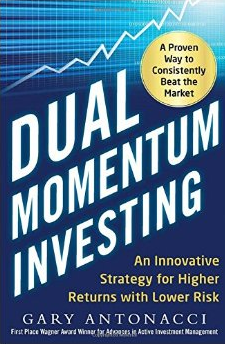The Momentum Investment Philosophy: An Innovative Strategy for Higher Returns with Lower Risk
- Gary Antonacci
- The book can be found here.
- Want to see all our book reviews?
Book Overview
If there is such a thing as a momentum investing “guru,” Gary Antonacci is that guru. He’s run the blog optimalmomentum.blogspot.com for a number of years, and has now published a book, “Dual Momentum Investing: An Innovative Strategy for Higher Returns with Lower Risk” (a copy is available here), that synthesizes his wide experience in momentum investing into a single approach, and makes it available to the investing public.

Personally, I have always found context to be an important tool for learning, and in finance, true understanding often requires knowledge of a broad range of subjects. And that’s a great thing about this book: it provides a historical, financial, and academic context that gives the reader a deep understanding of the investing world, and how momentum fits into it.
What I like about the book?
Rather than dive directly into a dry discussion of the momentum investment philosophy, Antonacci tells the story of momentum investing. He starts with the evolution of his own thinking, and an overview of the academic building blocks that give the reader a perspective on the overall investing landscape. He describes how early thinkers observed that stock prices were related to Brownian motion, the subsequent rise of the Efficient Market Hypothesis (EMH), and a common sense discussion of indexing.
But something wasn’t adding up for Antonacci, who thumbed his nose at EMH proponents at the University of Chicago (after being accepted into the PhD program there). He saw that certain respected and successful investors, such as George Soros and Paul Tudor Jones, were able to systematically beat the market. Even Nobel Laureate Paul Samuelson, who was an early architect of EMH, invested his own money with Warren Buffett. Meanwhile, in academia, researchers began to ask questions that EMH could not easily answer; they identified various market anomalies, and explored how behavioral finance research might explain them. Among the most puzzling of these anomalies was the momentum effect, which refers to persistence in performance.
Antonacci shares the history of momentum, discussing early momentum investor Jesse Livermore, Value Line’s successful use of relative price strength, and other early momentum practitioners, including early Mutual Funds that employed momentum. Next, Antonacci explores a range of insights generated within the academic community, such as Jegadeesh and Titman’s seminal 1993 paper, research across asset classes, and possible explanations and enhancements of momentum. Over time, momentum became known as the “premier anomaly,” and was among the most intensively researched areas in finance.
But there are a few more aspects of modern finance to put in place before getting into the nuts and bolts of various momentum strategies, which are detailed later in the book. Antonacci takes us through Markowitz’s mean-variance optimization, the Capital Asset Pricing Model, and the Black-Scholes option pricing model, all of which provide a framework and mathematical intuition for understanding momentum. We also see the “why” of momentum: Antonacci reviews risk-based and behavioral explanations, including from Kahneman and Tversky, and provides a solid overview of human biases that are thought to drive the momentum effect.
Next, Antonacci covers some ground on asset allocation topics, including a discussion of diversification, Bridgewater’s Risk Parity strategy, bonds as a diversifier, and a review of additional asset classes, including international and emerging markets, and commodity futures. Antonacci hints at how dual momentum and relative momentum can be used across these various asset classes as asset allocation and risk management tools, the specifics of which he gets into towards the end of the book. Antonacci also examines how to gain exposure to various factors, including size, value and momentum, and cautions investors against being seduced by the siren song of so-called “smart beta;” worthwhile advice in an age of misinformation in the financial services industry.
Finally, the stage is set for a discussion of the details of momentum, and Antonacci’s Dual Momentum strategy itself. Antonacci describes the well-known concept of relative strength momentum, and also defines the lesser-known absolute momentum. These are distinct branches of the momentum investment philosophy, and therein lies the unique contribution Antonacci makes with this book, since he describes way to combine these two powerful, independent effects in order to achieve a hybrid exposure that dynamically allocates within and across asset classes, thus creating superior risk-adjusted returns for the investor.
Antonacci demonstrates returns to Dual Momentum and the academic evidence through extensive backtesting across multiple decades; the research includes various risk metrics (returns, standard deviations, Sharpe, drawdowns, etc.), and robustness studies, the interpretation of which he explains in detail, so that the reader can have an informed view of the data.
The evidence culminates in a simple but powerful applied momentum model: Antonacci’s Global Equities Momentum (GEM) strategy, which uses these dual momentum ideas to tactically allocate across and among domestic and international equity and bonds. And the results are nothing short of spectacular: superior returns, with low volatility. When Antonacci regresses GEM returns against established factor models (3-, 4- and 5-factor models), GEM shows statistically significant excess risk-adjusted returns (alpha) across all of them. Antonacci even outlines an ultra-low cost, do-it-yourself approach for investing in GEM that uses tax efficient ETFs, and gets rebalancing signals from available free online sources.
Antonacci also discusses some interesting variations on dual momentum and related strategies, including trend following using moving averages (MA rules), market timing using valuation (CAPE), use of a 52-week high signal, sector rotation, and others. This is all fascinating material, but the book does have a few weaknesses.
Constructive Criticism
Antonacci is a little breezy and imprecise at times; for instance, he defines portfolio insurance as a concept “developed by several finance professors who said investors should increase their long exposure when markets move up quickly and decrease their long exposure when markets drop quickly.” That seems like perhaps a bit of an oversimplification of an idea that has been fairly extensively researched. It is a fairly complex area, however, so perhaps Antonacci simply didn’t want to get into too much detail. Also, some of the sections were a bit of a hodgepodge, and felt disjointed at times. For example, during a romp through modern portfolio theory, in the space of about a single page Antonacci leaps from Mandelbrot’s Cauchy distribution, to Bachelier’s early option pricing, to Long-Term Capital Management, in a sequence that left me slightly reeling.
It may be, however, that his book simply is not particularly geared for those who do not already possess a good degree of familiarity and facility across these somewhat obscure areas of finance. And in fairness, Antonacci also advises less interested readers they can skip lightly over the more heavily wonkish sections. Still, if you can’t keep up with Antonacci, perhaps you should read some other finance books first. Also, for those who are pushing the boundaries of their knowledge, Antonacci does include a helpful Glossary.
Summary:
Despite these shortcomings, which might render parts of Dual Momentum less than totally accessible to the layman, I thoroughly enjoyed the financial theory and academic history laid out in the book. And of the course the treatment of momentum is first rate. If you want to learn about the momentum investment anomaly, this book is an excellent place – or perhaps the best place – to start.
Momentum has been observed across financial markets over long time frames, but the momentum investment philosophy has yet to achieve widespread acceptance within the public. This is immensely puzzling. Ben Graham inspired legions of copy-cat value investors, but where is the Ben Graham of momentum and where are the legions of momentum traders? In a world where investors usually seek to combine uncorrelated risks of all stripes to achieve better risk-adjusted returns, momentum seems like a “no-brainer” addition to a portfolio. Yet this is often not the case.
Our own personal experience provides some anecdotal evidence. We visited a large ($4bn) university endowment recently who said they had no assets allocated to momentum strategies and seemed only vaguely familiar with the concept. That’s quite stunning when you think about it: momentum is arguably the most significant anomaly within financial academia, yet the endowments won’t touch it with a 10-foot pole. Amazing. Perhaps this is because many still view momentum, through an EMH lens, as “voodoo” finance. Or perhaps they just are unaware of the evidence. Regardless of the reasons, investors should seek out the benefits of momentum, and Gary Antonacci’s “Dual Momentum Investing” provides both a fantastic introduction to momentum investing, as well as a sophisticated discussion of and an approach to achieving risk-managed exposure to the anomaly across asset classes. I also heartily recommend it to anyone who wants to broaden their finance knowledge.
About the Author: David Foulke
—
Important Disclosures
For informational and educational purposes only and should not be construed as specific investment, accounting, legal, or tax advice. Certain information is deemed to be reliable, but its accuracy and completeness cannot be guaranteed. Third party information may become outdated or otherwise superseded without notice. Neither the Securities and Exchange Commission (SEC) nor any other federal or state agency has approved, determined the accuracy, or confirmed the adequacy of this article.
The views and opinions expressed herein are those of the author and do not necessarily reflect the views of Alpha Architect, its affiliates or its employees. Our full disclosures are available here. Definitions of common statistics used in our analysis are available here (towards the bottom).
Join thousands of other readers and subscribe to our blog.

